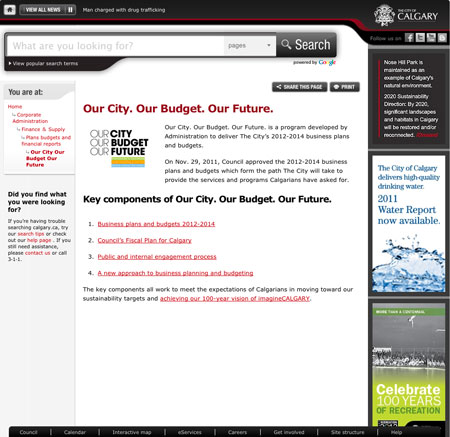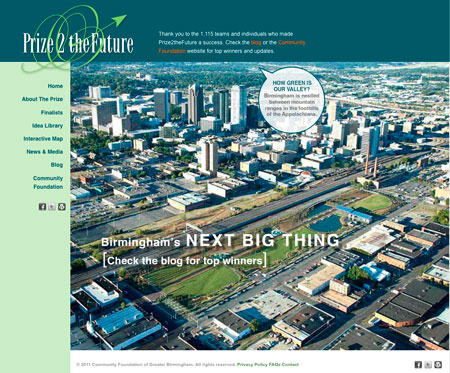New technologies are providing participatory platforms that allow individuals to share their ideas, interact with other's ideas, and work towards collaborative solutions to resolve problems or take advantage of opportunities. Kevin C. Desouza, PhD offers five guidelines to ensure that the use of such emerging technologies are maximized by practitioners.

To design and plan for smart cities we must have platforms that support the leveraging of intelligence and wisdom from a diverse set of stakeholders, sometimes referred to as "the crowd." Towards this end, it is important for designers and planners to understand how to construct, and manage participatory platforms. Simply put, participatory platforms can be seen as canvases that allow individuals to share their ideas, interact with other's ideas, and work towards collaborative solutions to resolve problems or take advantage of opportunities. While the concept of tapping collective knowledge is not new -- think about the traditional town hall meetings or the various committee forums -- today we can take advantage of technologies to design participatory platforms that bridge space and time constraints.
New technologies afford us not only the capacity to include more people, and more diverse sets of people, but also allow us to more deeply immerse ourselves in the design and planning elements. Consider simulation and modeling technologies, which allow us to visualize projects, study the emergence of interactions among various elements of a plan and system, and engage citizens by allowing them to participate in an immersive environment.
Let's look at Crowdsourced Moscow 2012, a public space game that simulates a virtual world resembling the City of Moscow, as one such example. A major issue facing Moscow today is the lack of public platforms for people to interact with each other. There are few avenues for people to discuss what they want in the city and convey this to the government agencies. Crowdsourced Moscow allows citizens to interact with a simulated model of Moscow consisting of several types of virtual agents like residents, city administrators, architects, and developers. Through the game, citizens understand the objectives, incentives, and values of each group of citizens (e.g. residents versus architects) and have to negotiate them to arrive at robust solutions for city problems. Some of these problems include the proposed construction of parking at Pushkin Square and the proposed demolition of the Peter I statue on Botony Island.
Over the last two years, and especially over the past six months since taking the helm as the Director of the Metropolitan Institute at Virginia Tech, I have been investigating the nature of participatory platforms and their relevance, value, and impact on the future of design and planning. Leveraging the intelligence of crowds in the design and planning of installations (e.g. buildings), systems, and even large ensembles (e.g. cities) is a non-trivial task. Planners need to learn how to orchestrate participation on these platforms so as to arrive at plans that are representative of community needs and within scope, budget, and resource constraints. Failure to achieve this will result in plans that fall prey to the foolishness or the rowdiness of crowds. Here are five simple guidelines to consider:
- Be inclusive, rather than exclusive: The beauty of advancements in technological capabilities, and the increased levels of engagement from the public on civic issues that these technologies make possible, is that we can now involve a more diverse set of stakeholders in the design and planning of our cities. Technology offers opportunities to contribute at one's leisure, rather than structured format of a public meeting and affords us the opportunity to connect with those that are spread across greater physical distances. Building smart(er) cities requires us to include diverse stakeholders, and especially those who are traditionally underrepresented and disadvantaged groups. A focus on inclusivity allows us the opportunity to engage our constituents into the planning process and have the community drive the acceptance, implementation and ultimate usage of the solution. We can involve those who are going to be directly impacted by the changes and developments being planned, and expand this inclusion to those who might feel the impacts third- or fourth-hand through cascading influences.

Consider an example of leveraging the crowd: The City of Calgary has taken steps to open up its budget process with a citywide engagement platform. In 2011, the City initiated a citywide engagement process -- "Our City. Our Budget. Our Future." -- to draft their three-year budget, by creating an online platform to share information and collect feedback. The City sought to address three main goals through this engagement technique: To simplify how the city reports the budget to the public, to create a space for the public to get that information and lastly, to hopefully inspire some good ideas to reform the budget. Through the platform, the City invited a quasi-crowdsourcing of its budget, and collected comments from approximately 24,000 citizens to help guide the formation of their budget. While the City did not adopt all the ideas collected during the seven-month engagement period, the input was valuable as a means of informing the government of citizen perspectives.
Although not the main goal of the engagement process, technological innovation played a major role in presenting the data, helping citizens to understand, and informatively interact with the budget. The online platform provided citizens with a budget-making tool, permitting them to view each department's expenditures and display the results of any adjustments to a department's budget. For example, the participants could see directly how a budget cut to the Parks and Recreation department would eliminate a number of programs. Through the use of this interactive tool, the resulting citizen comments were more informed and nuanced, and carried new weight with policy-makers. For the City of Calgary, it wasn't just about the data or the process; it was about both. In this case providing the data alone weren't enough to truly open the process and engage citizens. The online platform and tools were irreplaceable to their process of citywide engagement.
- Define the boundaries of the problem or opportunity: Planners must be adept at setting up the boundary conditions (the scope, constraints, variables that can be influenced) and clearly describing the problem and/or opportunity. Creativity and collaboration thrives under constraints. When engaging the community around a design and planning effort, take time to setup the challenge effectively (and efficiently). Specify the problem, the boundaries, and the kinds of solutions and approaches that are of interest. Clarify who can (and cannot participate), how should ideas be submitted, how will ideas be advocated for and screened for, and who will be responsible for choosing the most promising ideas for experimentation and prototyping. Define how will the community be engaged in the implementation, usage, and evaluation of the solution.
Thinking through these various facets is critical if you are to build a participatory platform that is robust and engaging. The critical focus of the participatory platform is to support innovation, entrepreneurship, and collaborative engagements around ideas. (For those interested in the dynamics of managing ideas within organizations, which can easily be applied to participatory platforms in the design and planning space, see Intrapreneurship: Managing Ideas within Your Organization (University of Toronto Press, 2011), especially the chapters four and six.)
- Promote empathy among the various players and stakeholders: Empathy among the stakeholders participating on the platform should be directed towards the generation of solutions. Empathy promotes understanding of others situation, context, realities, and points of view. Empathy allows one to connect emotionally with another and walk in their shoes. Empathy also allows stakeholders to take ownership of issues, rather than view them as someone else's problems or challenges.
Why is empathy important when we think of design and planning efforts? Simply put, without empathy, each stakeholder will be designing solutions that are not in congruence with the other's reality. Moreover, goodwill and a sense of community will be absent, as each stakeholder will view the other as the adversary, rather than a trusted partner. This will result in each one seeking to maximize their own objectives, at the expense of the overall goal of the project.
Participatory platforms that build empathetic connections among stakeholders do so in two important ways. First, they support the building of social ties between the various stakeholders by employing social networking technologies that build a sense of similarity among individuals participating. At the most basic level this involves having profile pages, where people can share details about their context (e.g. information on who they are, what are their interests, goals, etc.) and allow others to connect with them. Second, these platforms often support the exchange of rich media. Through promoting the sharing of videos, for example, individuals can see (and sometimes, even feel) the criticality of the issue, solution, viewpoint that is being expressed, better so than through simple text exchanges on an online discussion board. Ultimately, a focus on empathy-centric design of participatory platforms will lead to the creation of a viable collaborative space where collective intelligence can be creatively leveraged towards tackling complex problems.
- Do not order the crowd, rather inspire and support them in their efforts to arrive at an acceptable solution (or approach): This is probably the most challenging proposition; planners should resist the temptation to plan and control. Planners should take the role of orchestrating conductors, where they are able to leverage individual creativity and ingenuity, while allowing order to emerge from the interactions of individuals, rather than imposing it from above. While difficult, designers and planners need to embrace their role as receptive, behind-the-scenes, mediators of the platform. Designers and planners need to instigate moments that bring the community together to critically reflect on various phases of the problem-solving process. This can be done by either 1) taking the role of directly asking the community to engage in the evaluation and reflection on the process thus far, or 2) drawing the community's focus on artifacts and events that act as an attractor force for them to come together, mutually deliberate, and advance the cause of the project.
- Implement the community-generated solution and employ the community in the implementation process: The real reason one invests time in engaging a community in the design and planning processes is to take advantage of ideas that emerge from the wisdom of the crowds. As such, it would be a shame to not implement the solution that arose. At times, even with our best advice and prodding, people choose solutions that we think are not ideal. We get frustrated, and can even predict the disastrous outcomes that are forthcoming. Yet, we must bite our tongue and let them move along albeit with kind words that wish them well and hopefully an offer of support. Similarly, we need to allow the crowd to dictate and lead the effort for deciding what solution they want to implement, and how do they want to see the implementation process unfold. The planner's role in this effort should be to manage ideas and orchestrate them through the process of conceptualization to implementation.
I end this feature with a concluding example that highlights the potential of participatory platforms for leveraging wisdom of crowds in planning and designing smarter cities. Instead of relying on a small cohort of ‘experts' to interpret citizen needs and desires, citizens themselves develop and even implement solutions to urban issues.

In 2011, Birmingham, Alabama sponsored a competition for ideas to transform a portion of the city. The Prize2theFuture competition inspired over 1,000 teams from 39 countries to submit ideas for revitalizing a vacant area of downtown. Instead of hiring in a handful of developers, the city opened the process to the whole of the world and invited their visions for a crucial corner of their city. The $13 million assembled for the event and the subsequent development was gathered by into a Community Catalyst fund, notably from 54 new donors. The winning submission, One Birmingham Place, was a design that embraced the culture of social media and digital communication, with an iLab (an open-access computer lab), a Center for Modern Communication, a public display screen, and a theater.
The future of design and planning is certain to be around participatory platforms, designers and planners should embrace these platforms and leverage their potential towards designing smart(er) cities through open, inclusive, and collaborative approaches.
Kevin C. Desouza, PhD is the director of the Metropolitan Institute and an associate professor at the Center for Public Administration and Policy at Virginia Tech. Before joining Virginia Tech, he was an associate professor at the University of Washington (UW) Information School and held adjunct appointments in the UW's College of Engineering and at the Daniel J. Evans School of Public Affairs. He holds a visiting professorship at the Faculty of Economics, University of Ljubljana. Desouza has received over $1.4 million in research funding from both private and government organizations. For more information, please visit: www.kevindesouza.net.

Planetizen Federal Action Tracker
A weekly monitor of how Trump’s orders and actions are impacting planners and planning in America.

Chicago’s Ghost Rails
Just beneath the surface of the modern city lie the remnants of its expansive early 20th-century streetcar system.

Amtrak Cutting Jobs, Funding to High-Speed Rail
The agency plans to cut 10 percent of its workforce and has confirmed it will not fund new high-speed rail projects.

Ohio Forces Data Centers to Prepay for Power
Utilities are calling on states to hold data center operators responsible for new energy demands to prevent leaving consumers on the hook for their bills.

MARTA CEO Steps Down Amid Citizenship Concerns
MARTA’s board announced Thursday that its chief, who is from Canada, is resigning due to questions about his immigration status.

Silicon Valley ‘Bike Superhighway’ Awarded $14M State Grant
A Caltrans grant brings the 10-mile Central Bikeway project connecting Santa Clara and East San Jose closer to fruition.
Urban Design for Planners 1: Software Tools
This six-course series explores essential urban design concepts using open source software and equips planners with the tools they need to participate fully in the urban design process.
Planning for Universal Design
Learn the tools for implementing Universal Design in planning regulations.
Caltrans
City of Fort Worth
Mpact (founded as Rail~Volution)
City of Camden Redevelopment Agency
City of Astoria
City of Portland
City of Laramie




























